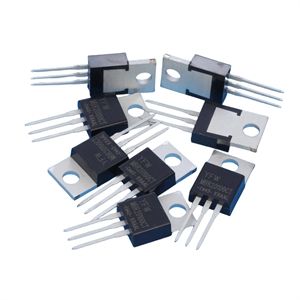Date:2024-10-06 Categories:Product knowledge Hits:298 From:Guangdong Youfeng Microelectronics Co., Ltd
Different types of diodes require different parameters. So, what are the main parameters of transient suppression diodes?
1. Minimum breakdown voltage VBR and breakdown current IR
VBR is the minimum breakdown voltage of TVS, and below this voltage, TVS will not experience avalanche at 25 ℃. When a specified 1mA current (IR) flows through the TVS, the voltage applied to the two poles of the TVS is its minimum breakdown voltage VBR. According to TVS
The degree of dispersion between VBR and the standard value can be divided into two types: 5% and 10%. For 5% VBR, VWM=0.85VBR; for 10% VBR, VWM=0.81VBR. In order to meet the international requirements of IEC61000-4-2
According to standards, transient suppression diodes must be able to handle a minimum of 8kV (contact) and 15kV (air) ESD shock, and some semiconductor manufacturers have adopted higher shock resistance standards in their products. For those with special requirements
With device applications, designers can select components as needed.
2. Maximum reverse leakage current ID and rated reverse turn off voltage VWM
VWM is the voltage that a diode can withstand under normal conditions. This voltage should be greater than or equal to the normal operating voltage of the protected circuit, otherwise the diode will continuously cut off the circuit voltage; But it also needs to be as normal as possible with the protected circuit
The working voltage is close, so as not to expose the entire circuit to overvoltage threats before TVS starts working. When the rated reverse turn off voltage VWM is applied between the two poles of TVS, it is in a reverse turn off state, and the current flowing through it should be less than or equal to
Its maximum reverse leakage current ID.
3. Maximum clamping voltage VC and maximum peak pulse current IPP
When a pulse peak current IPP with a duration of 20mS flows through the TVS, the maximum peak voltage appearing at both ends is VC. VC and IPP reflect the surge suppression capability of TVS. The ratio of VC to VBR is called the clamping factor, which is generally between 1.2 and 1.4. VC is the voltage provided by the diode in the cut-off state, which is the voltage passing through the TVS during ESD surge state. It cannot exceed the maximum voltage that the protected circuit can withstand, otherwise the device is at risk of damage.
4. Pppm rated pulse power, based on the maximum cut-off voltage and peak pulse current at this time
For handheld devices, a 500W TVS is generally sufficient. The maximum peak pulse power consumption PM is the maximum peak pulse power consumption value that TVS can withstand. At a given maximum clamping voltage, the greater the power consumption PM, the higher the surge current
The greater the tolerance. At a given power consumption PM, the lower the clamping voltage VC, the greater its ability to withstand surge currents. In addition, peak pulse power consumption is also related to pulse waveform, duration, and ambient temperature. Moreover, TVS can withstand it
The transient pulse of the device is non repetitive, and the specified pulse repetition frequency (the ratio of duration to interval time) is 0.01%. If there are repetitive pulses in the circuit, the accumulation of pulse power should be considered, which may damage the TVS.
5. Capacity C
The capacitance C is determined by the TVS avalanche junction cross-section and is measured at a specific frequency of 1MHz. The size of C is directly proportional to the current carrying capacity of TVS. If C is too large, it will cause signal attenuation. Therefore, C is the data interface circuit that uses TVS
Important parameters. For circuits with higher data/signal frequencies, the capacitance of the diode causes greater interference to the circuit, resulting in noise or signal attenuation. Therefore, the capacitance range of the selected device needs to be determined based on the characteristics of the circuit. High frequency circuit
Generally, capacitors should be selected as small as possible (such as LCTVS, low capacitance TVS, with a capacitance not exceeding 3pF), while circuit capacitors with low capacitance requirements can be selected above 40pF.
Note: The maximum clamping voltage VC for selecting TVS diodes should be less than the maximum safe voltage allowed by the circuit. If the cut-off voltage VRMM is greater than the maximum operating voltage of the circuit, it is generally possible to choose VRMM equal to or slightly greater than the maximum operating voltage of the circuit
Voltage.
The rated maximum pulse power (given in the TVS parameters) PM should be greater than the maximum transient surge power.

Previous: Classification, Structure, and Principle of MOSFET
Next: Using voltage inspection method to quickly locate fault points in integrated circuits